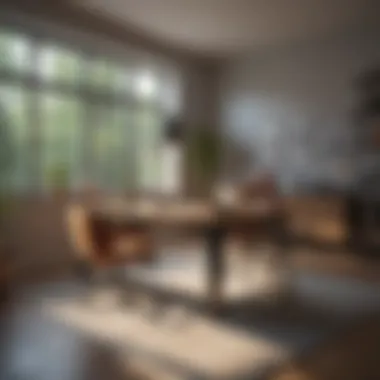Effective Lighting Tips for Your Home Office


Intro
Creating an ideal home office environment is crucial for comfort and productivity. The way we light our workspaces can significantly influenced how effectively we perform tasks. Inadequate lighting can lead to eye strain, decreased focus, and less motivation. By understanding the different types of light and their benefits, one can craft a setting that not only feels good but also promotes productivity and well-being.
In this article, we will delve into various strategies to optimize lighting in a home office. We will explore the importance of natural light, the effectiveness of artificial lighting, and the arrangement of lights within the space to meet the individual needs of homeowners and housewives alike.
Materials:
To implement effective lighting strategies, gathering the right materials is essential. Here’s what you might need to set up your optimal lighting:
- Natural Light: attempt to choose a room with large windows, ideally facing south or west
- LED Desk Lamp: look for one with adjustable brightness (around 400 lumens is ideal)
- Floor Lamp: a warm white LED floor lamp for ambient light
- Light Diffuser: used for softening bright lights
- Light Bulbs: a mix of daylight and soft white bulbs
- Curtains or Blinds: for controlling natural light levels
"An investment in high-quality lighting pays dividends in reduced eye strain and a boost in productivity."
DIY Steps
Step-by-Step Process
- Evaluate Room Layout: Find the best spot in your home that receives ample natural sunlight. Ensure the layout is comfortable.
- Determine Light Placement: Position your desk near the window. This allows you to work with the light instead of against it.
- Select Light Fixtures: Choose a high-quality desk lamp and floor lamp that complement your aesthetic while providing adequate illumination.
- Install Light Fixtures: Securely install the lamps according to their manuals. Ensure all connections are safe. This may involve plugging in or changing bulbs.
- Adjust Brightness: Experiment with brightness levels. Ensure that your workspace is well-lit but not glaring.
- Use Light Diffusers: If using harsh light, incorporate diffusers to soften the intensity.
Technical Aspects
Tools and Timing
To get your workspace just right, consider having these tools:
- Screwdriver
- Level Tool
- Measuring Tape
- Dimmer Switch (optional for adjustable brightness)
Timing specifics can vary; usually, a simple lamp installation can take around 30 minutes if there are no hurdles. However, the arrangement of multiple light sources may require additional time for preference adjustments.
DIY Project Process
Installation Methods
- When you position your desk lamp, place it on the side opposite to your dominant hand to prevent casting shadows on your work.
- If your floor lamp has multiple settings, try different brightness options until you find what suits your needs.
Troubleshooting Tips
- If you notice glare on your screen, consider using a diffuser or adjusting the position of your light fixture.
- Should your workspace feel too dark, review the placement of your lamps to ensure maximum coverage without excessive shadowing.
By following these strategies, homeowners can cultivate a workspace that maximizes efficiency and enhances well-being. A well-lit space fosters an inviting atmosphere, making work less of a chore and more rewarding.
Importance of Lighting in a Home Office
When it comes to establishing an effective home office, lighting plays a critical role that often gets overshadowed by factors like desk size or chair comfort. Yet, the right lighting can make all the difference between a productive day and one spent fighting fatigue. It directly influences not just how well you see your work but also your overall productivity, creativity, and well-being.
Impact on Productivity
In the hustle and bustle of daily tasks, effective lighting becomes a silent partner in enhancing our output. Bright, well-distributed light encourages focus and decreases the chances of errors. Without proper lighting, users often squint at their screens or strain their eyes, which can lead to fatigue and ultimately, lowered efficiency.
- Natural Light: Harnessing sunlight can invigorate a workspace. Studies suggest that individuals exposed to natural light tend to have higher engagement levels and satisfaction at work. It minimizes the risks of headaches and visual strain, allowing you to concentrate for longer periods. Maximizing windows or setting up mirrors to bounce light around can elevate the atmosphere considerably.
- Artificial Lighting: The evening comes, and sunlight retreats, but work doesn't have to stop. Adjustable artificial lighting plays an equally huge role. Using daylight-based bulbs can keep the mental momentum going, mimicking the sun's brightness. Invest in dimmable lamps too; these allow you to customize the ambiance to fit your individual tasks and mood. People often overlook how different lighting scenarios can impact concentration.
A well-lit desk can boost productivity and foster creativity, allowing ideas and thoughts to flow freely.
Effects on Mood and Well-Being


Lighting does more than help us see; it evokes feelings and emotions that can alter our mood. The right combination of illumination can create a workspace that promotes not just functionality but also happiness.
- Biophilic Benefits: Light influences our circadian rhythms, which manage sleep and alertness. Exposure to natural light during the day contributes to a better night’s sleep, and a good night’s sleep leads to better days, directly impacting mood. When your home office is flooded with natural light, it imitates being outdoors, generating a sense of well-being.
- Color Temperature Considerations: The spectrum of light affects our feelings as well. Warm light creates a cozy atmosphere, while cooler lights promote alertness. Balancing these can lead to a workspace that feels inviting yet stimulating, providing the perfect backdrop for creativity. Think of it as “layering” your light; like how we dress, sometimes it’s about finding the right combination to suit the task at hand.
"Light is perhaps the most important factor in any workspace. It shapes not only our vision but also our mood and motivation."
In sum, the importance of lighting in a home office stretches far and wide. It creates a backdrop for productivity and shapes the emotional responses of individuals working within that space. Getting it right can lead to a more comfortable, inviting, and efficient workspace that feels like your own personal sanctuary.
Types of Lighting for Home Office Environments
Lighting plays a pivotal role in shaping the work environment, impacting everything from productivity to health. The right mix of lighting types not only enhances the aesthetic appeal of the workspace but also plays a crucial role in maintaining focus and preventing fatigue. A well-lit home office can minimize distractions, making it a foundational aspect of any productive workspace.
Natural Light
Benefits of Sunlight Exposure
Natural light is, without a doubt, a treasure trove for any home office. It's readily available during the day, cuts down on electric bill costs, and can even elevate mood significantly. Exposure to sunlight boosts levels of serotonin in the brain, which can heighten mood and general well-being. This natural light reduces the likelihood of eye strain, a common complaint among those glued to screens for hours on end. Additionally, the warmth and vibrancy of sunlight create a welcoming environment that simply cannot be imitated by artificial alternatives.
The constant shifting of natural light throughout the day can adjust the ambiance of a space beautifully, providing a fresh feel as the hours pass.
How to Maximize Natural Light
To fully harness the power of natural light, one must strategically plan the home office layout. Positioning your desk near windows is key. If possible, opt for sheer curtains that allow sunlight to flood in while reducing glare on screens. Mirrors can be a secret weapon, reflecting light and making the space feel larger and brighter. Consider using light-colored walls and furniture to amplify the light's effect; whites and soft pastels work well for this. While it's tempting to keep the blinds drawn for privacy, this can be a disservice to productivity. Encouraging a bright environment through smart design choices truly pays off.
Ambient Lighting
Definition and Purpose
Ambient lighting serves as the foundation of any lighting design in a home office. This general illumination allows a workspace to be functionally bright without being stark or harsh. Think of it as the canvas upon which all other types of lighting are layered. The key characteristic of ambient lighting is its ability to fill a room with soft, diffuse light, providing a comfortable background that supports activities from reading to writing. It's not there to spotlight specific areas, but rather to create a consistent brightness across the room.
Recommended Fixtures
When choosing fixtures for ambient lighting, overhead options like flush mounts or chandeliers can set the right tone. However, floor lamps and table lamps also belong in this category, offering flexibility in brightness and positioning. The magic often lies in combining these light sources to create a well-rounded effect. Adjustability is a huge plus here—dimmer switches can transform ambient lighting's intensity to suit different tasks or moods. This adaptability allows for a more personalized workspace experience.
Task Lighting
Key Features
Task lighting is tailored for focused work areas—think of it as the spotlight over your desk. The primary feature of task lighting is its directed focus, illuminating specific areas without spilling too much light into the surroundings. This focused beam helps reduce eye strain, especially in the nuances of reading small print or writing. A well-placed task light helps guide your attention, creating an atmosphere conducive to concentration.
Choosing the Right Task Lamp
When selecting a task lamp, look for features like adjustable arms and color temperature controls. A lamp with a flexible arm allows you to direct light precisely where you need it, making a world of difference when working late into the evening. LED options are often favored for their energy efficiency and ability to emit less heat while still providing bright, clear light. Finding the right lamp is a balance between aesthetics and function, aiming to foster that focused work environment.
Accent Lighting
Role in Home Office Design
Accent lighting adds character and depth to a home office, playing a subtle yet significant role. It's more decorative than functional, and it highlights specific features in the space, from art pieces to bookshelves. This type of lighting creates visual interest, helping to establish a mood that can inspire creativity. A well-designed lighting scheme incorporates accent lighting to offer a warm glow that complements the main light sources.
Examples of Accent Lighting Solutions
Some popular choices for accent lighting include wall sconces, pendant lighting, or even LED strips along shelves. These fixtures enhance architectural features and create points of interest in an otherwise monochromatic office setup. Accent lighting should blend seamlessly into the workspace, enhancing its appeal without overwhelming the overall aesthetic. For instance, placing a small spotlight on a plant or a framed photo can elevate the entire feel of the space. Such minor details can make a significant impact, showcasing the thoughtfulness behind the design.
Factors to Consider When Selecting Lighting
Choosing the right lighting for your home office goes beyond merely picking a few lamps and calling it a day. It's a fine art that can significantly influence not only the space’s functionality but also your overall sense of well-being. Factors such as room size, color temperature, and control systems play crucial roles in crafting an environment conducive to focus and productivity.
Room Size and Layout


Small vs. Large Spaces
In a small office, every inch counts. The key characteristic of small spaces is their need for efficiency and practicality. A well-illuminated small office can feel more open and inviting. Utilizing natural light sources, like windows, complemented by strategic task and ambient lighting provides balance without cluttering the space. Conversely, large spaces allow for more flexibility in lighting design. You have the opportunity to create zones, which can enhance productivity but also demand careful consideration of how each lighting choice interacts with the overall layout.
In both scenarios, it’s beneficial to think about how light will distribute within the space. For small offices, wall sconces and upward lighting can create a sense of height, while in large ones, consider using dimmable fixtures or multiple sources to prevent harsh shadows that can lead to distraction or stress.
Furniture Arrangement Implications
The arrangement of furniture can heavily influence how you implement lighting. For example, in a small office, the key might be to position your desk close to windows, maximizing natural light and limiting the need for excessive artificial illumination. For larger areas, placing furniture away from windows might create a cozy nook, but you need to ensure adequate task lighting on surfaces where work will be done.
Proper furniture arrangement can optimize light flow and function. Think about your workflow—if you often refer to books or screens, where will those be in relation to light sources? Your comfort and effectiveness hinge on understanding these implications; a well-thought-out arrangement leads to a harmonious blend of light and function in your workspace.
Color Temperature
Warm vs. Cool Light
Color temperature refers to the hue of the light emitted—warm light gives off a cozy, yellowish glow, while cool light provides a brighter, bluish-tinted illumination. The unique feature of warm light is its ability to create a comforting environment that can foster calmness and reduce stress. This makes it a popular choice among homeowners who want to avoid eye strain during long working hours. On the flip side, cool light can enhance alertness and is often favored in work environments that demand high focus and concentration.
Choosing between the two largely depends on the tasks at hand. A beneficial strategy might include incorporating both types, using warm light for relaxation during breaks and cool light for focused work hours, ensuring versatility in your home office.
Effects on Concentration and Eye Strain
Lighting can have profound effects on your concentration levels and eye health. Dim lighting often leads to difficulties in focusing, making one more prone to distractions. The slighest strain on your eyes can result in headaches and fatigue, severely affecting productivity. On the other hand, overly bright light can cause glare, doing just as much harm.
A perfect lighting setup will balance brightness and reduce glare, helping maintain optimal focus. Consider adjustable lighting that can be modified based on the time of day or type of work you’re doing, creating a tailored approach to illumination in your home office.
Dimmer Switches and Control Systems
Benefits of Dimming
Dimmer switches provide an elegant solution for varying light levels depending on the time of day or nature of your tasks. They allow you to alter the brightness, creating a welcoming atmosphere that can boost motivation during intensive work sessions or provide calming light when winding down. The unique benefit of dimming is the versatility it offers, allowing seamless transitions from work to relaxation without needing multiple fixtures or intense changes in lighting.
Incorporating dimmers can lead to reduced energy consumption, extending the life of bulbs and lowering electricity bills in the long haul.
Smart Lighting Options
Smart lighting systems offer the ultimate convenience in managing your home office lighting. You can control them through smartphone apps or voice commands, allowing immediate adjustments to brightness, color temperature, or even pre-programmed settings suitable for different activities. This technology is diverse and adaptable, enabling a tailored experience uniquely aligned with your needs throughout the day.
Still, it’s essential to consider installation challenges and initial costs, which might deter some homeowners. But the long-term benefits—greater flexibility and energy efficiency—often outweigh the costs.
Effective lighting not only enhances the aesthetic appeal of your workspace but also serves as a critical factor for your concentration and well-being.
Best Practices for Lighting Arrangement
Creating the right atmosphere in your home office goes beyond just grabbing a lamp and turning it on. Well-thought-out lighting strategies can significantly influence how efficiently you work and how comfortable you feel in your space. The goal here is to strike a balance between different lighting sources, ensure optimal visibility, and cultivate an environment conducive to focus and productivity.
Combining Different Types of Lighting
Utilizing various lighting types not only brightens up a room but also provides functionality tailored to different tasks. By blending ambient, task, and accent lighting, one can create a layered effect that elevates the workspace's aesthetic and enhances its usability. For instance, ambient lighting sets the overall tone and brightness, task lighting directs you specifically for activities requiring focus, like reading or writing, and accent lighting adds character to the space, highlighting art or decor.
By adopting this multi-layered approach, you're setting your home office up not just for work but for comfort and creativity. Just think of it like making a good stew; the right mix of ingredients can create something wonderful.
Optimal Placement of Light Sources
Positioning Overhead Fixtures


When it comes to overhead fixtures, placement is crucial. Typically, these lights are installed centrally in the room, illuminating the area evenly. The key characteristic of overhead lighting is its ability to flood the space with illumination, which can be particularly beneficial in larger areas where shadows may play hide and seek. It’s a popular choice because it creates a uniform base of light that complements task-specific lighting.
Overhead fixtures like recessed lights or pendant lamps can serve as an anchor for your lighting scheme. For those seeking minimalistic design, recessed lighting offers a sleek look while ensuring that your work area remains well-lit. However, you should keep in mind that if they are too high or the fixture is too bright, it can lead to glare, which is less than ideal for staring at a screen all day.
Strategic Desk Lamp Location
The desk lamp is one of the best allies in your work environment arsenal. By placing your desk lamp on one side of your desk—ideally the side opposite to where your dominant hand is—you can reduce glare on your monitor. This aspect of strategic desk lamp location is vital because it helps avoid eye strain, which can derail an otherwise productive session.
Desk lamps come in various styles, from those with adjustable arms to minimalist designs for modern aesthetics. The unique feature of having a personal desk lamp is its adjustability in both light intensity and angle, allowing you to create the perfect reading nook or focus zone. On the downside, if you pick a lamp that emits too warm or harsh a light, it might not provide adequate brightness for detailed tasks, so it’s important to consider both options carefully.
"The right lighting can set the stage for creativity and effectiveness in your workspace."
Common Mistakes in Home Office Lighting
Lighting might not be the first thought when setting up a home office, but getting it right can make a world of difference. Many folks underestimate the pitfalls they can encounter when dealing with lighting solutions. A poorly lit work area can not only hamper productivity but also impact overall well-being. The takeaway? Recognizing these common mistakes is key to creating a space that truly supports your work.
Over-reliance on Artificial Light
In many home offices, individuals lean heavily on artificial lighting. Sure, it’s convenient and often necessary. However, over-reliance on artificial light can backfire. Natural light can significantly boost mood and productivity. If your workstation is illuminated solely by bulbs, it might lead to feelings of fatigue and strain, particularly in the eyes. The glare from harsh, cold lights can make it tough to concentrate.
To find a balance, consider designing your workspace to take advantage of windows and sunlight. Position your desk near a window if possible. Allow sunlight to stream in during the day. A good rule of thumb is to use a combination of natural light and soft, ambient lighting. Including plants or light-colored curtains can help to diffuse sunlight, creating a gentle glow that uplifts the space.
"Natural light is the best light. Not only does it help you see better, but it can also have a profound effect on your mood and energy levels."
Poorly Chosen Light Bulbs
Choosing the right light bulbs is like picking the right spice for a recipe; the wrong choice can ruin the whole experience. Not all bulbs are created equal, and using the wrong type can lead to unwanted results. For example, fluorescent bulbs may appear efficient, but they can cast a sickly hue that feels draining.
In contrast, LED bulbs can offer both energy efficiency and a range of color temperatures. But here’s the catch: not all LEDs are warm and inviting. Choosing cooler-colored LED bulbs might create an overly sterile environment, which can alienate your creative thoughts. Therefore, be wise about your selection.
Here’s a quick checklist:
- Warm White (2700-3000K): Great for cozy, relaxing vibes.
- Cool White (4000-5000K): Good for workspaces requiring focus, but use with caution.
- Daylight (5000K and above): Mimics natural sunlight – ideal for artists or detailed tasks.
A little experimentation with light bulbs might just lead you to discover what works best in your space. It’s worth considering how various color temperatures make you feel and function in the workplace.
Future Trends in Home Office Lighting
In the ever-evolving world of home workspaces, staying ahead of the curve in lighting strategies is essential. Not only does it enhance the overall aesthetics of the workspace, but it also significantly influences productivity and comfort levels. This section delves into two crucial trends reshaping home office environments: the integration of smart technology and the rise of sustainable lighting solutions. Both aspects not only aim to improve the work experience but also reflect a growing awareness of energy consumption and environmental impact.
Integration of Smart Technology
The conventional approach to home office lighting is gradually shifting as smart technology takes center stage. Integrating devices such as smart bulbs and automated systems offers unprecedented control over lighting conditions. For instance, voice-activated assistants like Amazon Echo or Google Home can easily manage lighting settings through simple commands, allowing users to set the ambiance with ease.
Moreover, smart lighting systems can be programmed to adjust based on the time of day. Imagine sunlight imitating colors in the morning, gradually transitioning to a warmer shade in the evening. These systems not only create a more pleasant working environment but also aid in regulating our circadian rhythms, which is crucial for maintaining focus throughout the day.
Here are a few considerations when embracing smart technology for your home office:
- Remote Access: Control your lights even when you're not home, ensuring that your office feels welcoming whenever you walk in.
- Energy Efficiency: Many smart bulbs use significantly less energy than traditional bulbs, translating to lower electricity bills over time.
- Customizable Settings: Create tailored preset moods—whether for brainstorming, focused work, or winding down—all with a few taps on your smartphone.
"Smart lighting transforms not just how we illuminate spaces but how we interact with them."
Sustainable Lighting Solutions
In a society increasingly concerned with sustainability, eco-friendly lighting solutions are gaining traction in home office setups. This shift is not merely a trend but a necessity as homeowners look to reduce their carbon footprint. LED lights are at the forefront of this movement, consuming a fraction of the power compared to traditional incandescent bulbs while boasting longer lifespans.
Beyond just switching to energy-efficient bulbs, sustainable lighting encompasses a broader approach, including the utilization of natural light and energy-generating solutions. For instance, solar-powered lights offer an attractive alternative for those who want to harness renewable energy, providing robust illumination during daylight hours and beyond.
Here are some key points regarding sustainable lighting:
- Use of Natural Light: Designing your office layout to optimize natural light not only saves energy but also enhances mental well-being by connecting you with the outdoors.
- Recyclable Materials: Look for light fixtures made from recyclable or sustainable materials, reducing waste and promoting eco-conscious living.
- Smart Sensors: Incorporate motion sensors and daylight harvesting systems that adjust lighting automatically based on occupancy and natural light levels.
In summary, as the demand for home office spaces grows, so does the need for innovative lighting solutions. Embracing smart technology and sustainable practices can lead to not only a more effective work environment but also contribute positively to our planet's health. Keeping an eye on these trends ensures that your home office remains both functional and forward-thinking.







